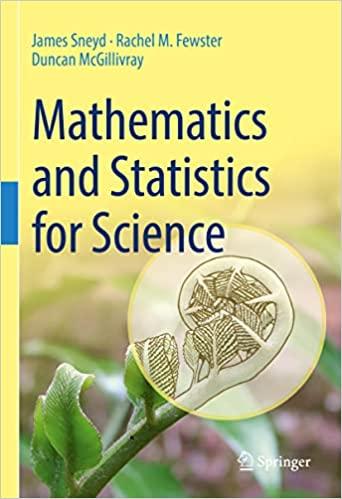If there is an outbreak of measles in a school, suppose that children who have not been
Question:
If there is an outbreak of measles in a school, suppose that children who have not been immunised have probability 0.9 of catching it, whereas children who have been immunised have probability 0.05 of catching it. In the population under study, the immunisation rate of children against measles is 0.86.
An outbreak of measles occurs at a school of 500 children.
Define the sample space Ω = {children at the school}, event I that a child has been immunised against measles, and event M that a child catches measles during the outbreak. Assume that outcomes are independent for all children.
a. Show that P(M) = 0.169.
b. Let X be the number of the 500 children who catch measles during the outbreak. Give the distribution of X, stating the values of any parameters. Hence find E(X) and Var(X).
c. Explain why X can be viewed as the sum of a large number of independent random variables from the same distribution. Hence explain why the distribution of X is approximately Normal(µ, σ
2 ), and specify the values of µ and σ
2 .
d. Use the normal approximation to give an interval in which X is roughly 95% likely to fall. You do not need to use R.
Hence, sketch the approximate distribution of X, marking the interval on your sketch as well as µ. Add to your sketch the approximate area under the curve within the interval, and the approximate values of the two areas in the upper and lower tails outside the interval. You may assume that the normal distribution is a very close approximation to the distribution of X.
e. At the end of the outbreak, the school observed that a total of X = 98 children caught measles. As this number seems quite large, they want to test whether the level of immunisation in the school is lower than the national average.
Let p be the probability that a child at the school is immunised against measles. Using the observation that X = 98 children caught measles, carry out a test of the hypotheses H0 : p = 0.86 H1 : p , 0.86.
Instead of using R to find the P-value, say what you can Remember that you don’t observe immunisation status directly. You only observe the measles outcomes.
Your first step is to rewrite the hypotheses in terms of what they imply about the distribution of X.
about it using the insights you’ve gained from the previous parts of this question. Include an appropriate sketch. Interpret your findings for the school in terms of whether there is evidence of an abnormal immunisation rate.
Step by Step Answer:

Mathematics And Statistics For Science
ISBN: 9783031053177
1st Edition
Authors: James Sneyd, Rachel M. Fewster, Duncan McGillivray





